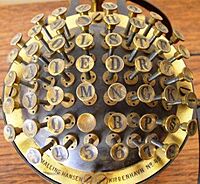Hansen Writing Ball facts for kids
The Hansen Writing Ball was one of the very first typewriters ever made. It was invented in 1865. It became available for sale in 1870. This makes it the first typewriter sold to the public.
Contents
What Was the Writing Ball?
The writing ball (called skrivekugle in Danish) was invented by Rasmus Malling-Hansen. He was a reverend and also the head of the Royal Institute for the Deaf-Mutes in Copenhagen, Denmark. He created this machine in 1865.
The Hansen Writing Ball looked very unique. It had 52 keys placed on a large round brass shape. This made it look a bit like a giant pincushion. Malling-Hansen's daughter, Johanne Agerskov, wrote about how her father experimented. He used a porcelain model to figure out the best place for each letter key.
He wanted to make typing as fast as possible. So, he put the most used letters where the fastest fingers could reach them. He also placed most of the vowels on the left side and consonants on the right. The keys had short rods that went straight through the ball. All these features helped people type very quickly.
Like many early typewriters, you couldn't see what you were typing right away. The paper was hidden as it moved through the machine.
-
A sample from a letter written by Rasmus Malling-Hansen in 1872 to his brother Jørgen on the writing ball
How the First Models Worked
The first writing ball models typed onto paper wrapped around a cylinder. This cylinder could move around and also slide from side to side. This allowed the user to manually arrange and space the letters. You would attach white paper and carbon paper to the cylinder with clips.
These early models also used an electromagnet. This electromagnet controlled how the typewriter moved. This made Malling-Hansen's machine the first electric typewriter! A battery with 10 or 12 cells powered the electromagnet. It controlled a special clockwork part called an escapement. This part moved the paper carriage a set amount each time a key was pressed.
Making the Writing Ball Better
Malling-Hansen kept improving his invention during the 1870s and 1880s. In 1874, he patented a new model. This version replaced the cylinder with a flat paper-holding frame. The electromagnet and battery still moved the paper. This new design helped reduce typing mistakes.
He improved it even more, creating a curved frame to hold a single sheet of paper. This well-known model was first patented in 1875. In this version, a mechanical escapement replaced the battery. All these changes made the writing ball simpler and smaller.
Sales and Famous Users
The Hansen Writing Ball was shown at big exhibitions. It was at a large industrial show in Copenhagen in 1873. It was also at the world exhibition in Vienna in 1873. And it was at the Paris exhibition in 1878. It won several awards throughout the 1870s.
People bought the writing ball in many European countries. It was even used in offices in London as late as 1909. However, each writing ball was made by hand. This meant it was more expensive and slower to produce. Because of this, it was eventually replaced by the Sholes and Glidden typewriter. This machine was mass-produced by E. Remington and Sons starting in 1873.
Malling-Hansen also invented other machines. He created a very fast writing machine for stenography called the Takygraf. He also invented a copying method called the Xerografi. Both of these were invented in 1872.
Today, complete Hansen Writing Balls are very rare. They can sell for hundreds of thousands of Euros at auctions.
Nietzsche and His Writing Ball
In 1881, the famous philosopher Friedrich Nietzsche had trouble with his eyesight. He wanted to buy a typewriter so he could keep writing. We know from letters to his sister that he talked directly with "the inventor of the typewriter, Mr Malling-Hansen from Copenhagen." He told his sister he had received letters and a typed postcard as an example.
Nietzsche received his writing ball in 1882. It came directly from the inventor, Rasmus Malling-Hansen, in Copenhagen, Denmark. It was the newest model, a portable one with a color ribbon. Its serial number was 125. About 60 of Nietzsche's typed writings are known to exist from this machine.
Nietzsche knew about the newer model from E. Remington and Sons. But he wanted a portable typewriter. So, he chose the Malling-Hansen writing ball because it was light and easy to carry. Unfortunately, Nietzsche was not completely happy with it. He never really became good at using the machine.
Many ideas explain why Nietzsche didn't use it more. Some say it was "defective." New research suggests the machine was damaged during shipping to Genoa, Italy, where he lived. When he took it to a mechanic who didn't know how to fix typewriters, the machine got even more damaged.
Nietzsche believed that his writing tools affected his thoughts. He famously wrote in 1882, "Our writing instruments contribute to our thoughts." He even wrote a poem about his writing ball on February 16, 1882.






